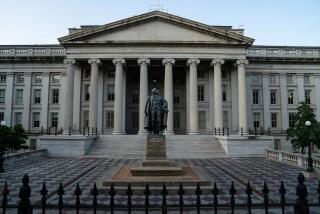THE BUDGET BATTLE : Tiny Gap in Projections a Big Issue : Budget: Congress and the White House support dueling forecasts of economic growth. The sliver of difference becomes huge over seven years.
- Share via
WASHINGTON — It had tied the government in knots, idled 800,000 federal workers, closed the national parks and, more important, jeopardized crucial government benefit payments and other activities.
What difference between the Republican majority in Congress and the Democrats in the White House could possibly have had such far-reaching consequences?
A difference of one-tenth of a percent. Or, to be precise, nine one-hundredths of a percent.
That is the gap between the competing projections of the President’s Office of Management and Budget and the Congressional Budget Office as to how much the nation’s economy will grow annually over the next seven years.
It may sound trivial. But in fact, it perfectly encapsulates the profound differences between the two parties over the proper role of the federal government in American society.
Sunday’s agreement does nothing to narrow those differences. As House Minority Leader Richard A. Gephardt (D-Mo.) said, it “preserves everybody’s options.”
“The issue was never whether we should balance the budget,” Gephardt said. “The issue was how it should be done.”
In that context, the projected economic growth rate becomes critically important.
The OMB is predicting average economic growth of 2.47% a year over the next seven years. The CBO forecasts 2.38%.
Compounded over seven years, this seemingly trivial difference spells a cumulative economic output of trillions of dollars more under the OMB’s projections than the CBO’s.
And because more economic output means more tax revenue, federal deficits over the seven years would be a total of $475 billion less if the OMB is right than if the CBO is correct. That means spending cuts of $475 billion less under President Clinton’s budget than under the Republicans’.
For the year 2002 alone, the OMB assumptions would lead to a deficit of $216 billion in the absence of spending cuts or tax increases. The CBO projections would yield a deficit of $340 billion.
Over the years, neither the OMB nor the CBO has demonstrated a lock on accurate economic growth projections. That they are so close in their estimate of average growth over the next seven years suggests that actual growth will be either a lot higher or a lot lower.
“There’s a huge amount of uncertainty concerning where the economy will be seven years from now,” said Robert D. Reischauer, a senior fellow in economic studies at the Brookings Institution who until recently headed the Congressional Budget Office. “OMB’s numbers are well within the range of the possible, as are CBO’s.”
Indeed, the consensus of 50 prominent private economists surveyed by Blue Chip Economic Indicators is for growth of 2.42% over the same period.
The OMB’s economic forecasting unit, run by Republicans for the 12 years before Clinton’s inauguration in 1993, has typically been on the high side with its forecasts.
Democrats frequently chided the presidential budget office for offering “rosy scenarios” to justify Republican plans.
If the past is a guide, to determine which office may end up the more accurate, consider these figures:
The OMB’s prediction of economic growth came within one-tenth of a percentage point of actual growth--mighty close--during the two-year period 1992-1993.
But it overshot the mark by 1.8 percentage points--not so close--in the recession years 1991 and 1992.
For those same periods, the congressional office was off target by three-tenths of a percentage point and 1.1 percentage points.
Mistakes of that magnitude would make a mockery of all projections today as to whether the budget will be balanced by the year 2002.
More to Read
Get the L.A. Times Politics newsletter
Deeply reported insights into legislation, politics and policy from Sacramento, Washington and beyond. In your inbox twice per week.
You may occasionally receive promotional content from the Los Angeles Times.










